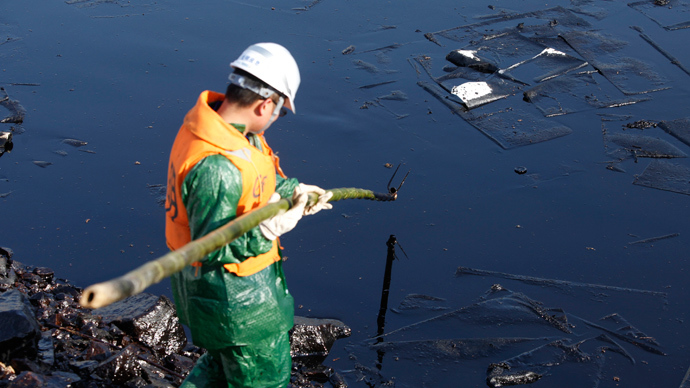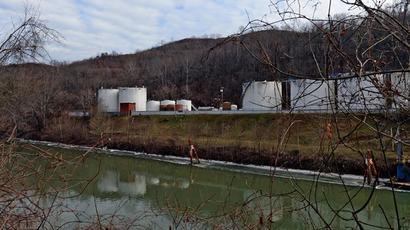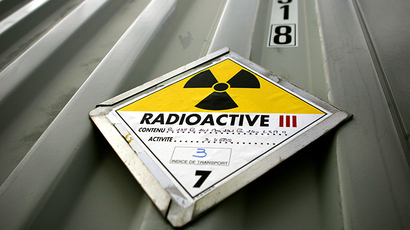Cleanup of major toxic waste sites an ‘inefficient,’ unaccountable ‘shell game’

Energy-intensive cleanup efforts at toxic-waste sites in the US government’s Superfund program ultimately amount to a shell game, where poisonous materials are constantly shuffled between treatment plants, all as harmful waste multiplies with each step.
Tracking noxious material that is removed from Superfund areas – or uncontrolled hazardous waste sites the US government has dedicated resources to cleaning – beyond the first stop is basically futile, much less can the country’s environmental regulators actually succeed in reducing toxic waste or curbing new health and environmental hazards created by such efforts.
In attempting to assess what even regulators say is beyond their capacity – or interest – a new report from The Center for Investigative Reporting and the Guardian found that the modern process of rehabilitating toxic sites is costly, inefficient, and, since “waste begets waste,” basically hopeless.
The investigation uses toxic water pools deep underneath California’s Silicon Valley – the pools are part of three Superfund sites known as Middlefield-Ellis-Whisman Study Area – as a fairly typical scenario among 1,300 nationwide Superfund cleanup efforts.
Below the pristine campuses of the likes of Google Inc. and Symantec Corp., "pipes and pumps suck thousands of gallons of contaminated water every hour from vast" underground basins into massive industrial filters that attempt to remove dangerous chemicals from groundwater at the surface. This is only the beginning, investigators write.
“Once it leaves Mountain View, Calif., the toxic waste gets shipped, treated and burned in places like Oklahoma and Arizona, discharging waste in small towns and on a Native American reservation, and in some cases creating even more harmful chemicals, The Center for Investigative Reporting has found.”
“Along the way, waste treatment plants rack up environmental violations, records show. Byproducts created during treatment are shuttled from one plant to another. And then another. After crisscrossing the country, the waste even can end up right back where it started – at a treatment plant just a few miles away in Silicon Valley.”
The report states that it would take 700 years of constant treatment to make the groundwater under parts of Silicon Valley drinkable once again.
“There’s really no such thing as throwing something away,” US Environmental Protection Agency (EPA) spokesman Rusty Harris-Bishop told The Center for Investigative Reporting. “You’re always throwing it somewhere.”
Once lethal waste is hauled out of an area, federal environmental regulators are finished with tracking it. To construct such an unprecedented investigation, the news outlets said they had to piece together “hazardous waste shipping documents, company records, environmental violations and scientific studies.”
“It’s not that we don’t care about the material,” said Carlos Pachon, EPA administrator for waste cleanup. “We just don’t have control over it."
The report goes on to paint an increasingly grim picture of industrial-level chemical use and the processes that aim to get rid of toxic elements before environmental contamination and, ultimately, human consumption.
For instance, the report says, “waste begets waste.”
“At every step along the trail, treatment leaves behind a new batch of waste that needs to be shipped somewhere else. At one stop, a plant in Wisconsin creates more waste than it takes in.”
Waste treatment also causes the emission of contaminants like cancer-causing dioxins and other “dirty dozen” chemicals.
“The superheating used to release toxic chemicals gives way to an equally alarming danger that isn’t monitored: dioxins. After they escape the plants, dioxins can build up in the food supply and have been linked to cancer and birth defects.”
Despite its good intentions, the Superfund treatment system is grossly inefficient.
“For every 5 pounds of contaminants pulled from the ground, roughly 20,000 pounds of carbon dioxide are produced from continually running pumps, cross-country treks and treatment plants that produce as much greenhouse gas as municipal power plants.”
Ultimately, the Superfund program’s goal is seemingly out of reach.
“Cleanup at the Silicon Valley site, and others like it, isn’t working. Over the past decade, the pollution there has remained stagnant despite constant pumping. In some cases, the treatment is actually increasing the pollution in the water.”
And the costs of waste treatment are high. Sites like the Silicon Valley sites will, by EPA estimates, require between $1.2 billion and $3.6 billion over the next 30 years.
There are 450 other Superfund sites like the Silicon Valley sites, where soiled groundwater is so complicated to clean that “experts have lost faith in the technology used to clean it up.”














